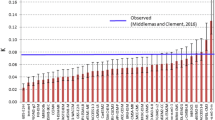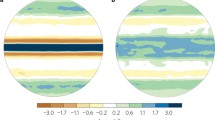Abstract
Radiative forcing has been widely used as a metric of climate change, i.e. as a measure by which various contributors to a net surface temperature change can be quantitatively compared. The extent to which this concept is valid for spatially inhomogeneous perturbations to the climate system is tested. A series of climate model simulations involving ozone changes of different spatial structure reveals that the climate sensitivity parameter λ is highly variable: for an ozone increase in the northern hemisphere lower stratosphere, it is more than twice as large as for a homogeneous CO2 perturbation. A global ozone perturbation in the upper troposphere, however, causes a significantly smaller surface temperature response than CO2. The variability of the climate sensitivity parameter is shown to be mostly due to the varying strength of the stratospheric water vapour feedback. The variability of the sea-ice albedo feedback modifies climate sensitivity of perturbations with the same vertical structure but a different horizontal structure. This feedback is also the origin of the comparatively larger climate sensitivity to perturbations restricted to the northern hemisphere extratropics. As cloud feedback does not operate independently from the other feedbacks, quantifying its effect is rather difficult. However, its effect on the variability of λ for horizontally and vertically inhomogeneous perturbations within one model framework seems to be comparatively small.





Similar content being viewed by others
References
Bintanja R, Fortuin JPF, Kelder H (1997) Simulation of the meridionally and seasonally varying climate response caused by changes in the ozone concentration. J Clim 10:1288–1311
Bojkov RD, Fioletov VE (1997) Changes of lower stratospheric ozone over Europe and Canada. J Geophys Res 102:1337–1347
Brewer AW (1949) Evidence for a world circulation provided by measurements of helium and water vapour distribution in the stratosphere. Q J R Meteorol Soc 75:351–363
Cess RD, Potter GL, Blanchet JP, Boer GJ, Del Genio AD, Déqué M, Dymnikov V, Galin V, Gates WL, Ghan SJ, Kiehl JT, Lacis AA, Le Treut H, Li Z-X, Liang X-Z, McAvaney BJ, Meleshko VP, Mitchell JFB, Morcrette J-J, Randall DA, Rikus L, Roeckner E, Royer JF, Schlese U, Sheinin DA, Slingo A, Solokov AP, Taylor KE, Washington WM, Wetherald RT, Yagai I, Zhangi M-H (1990) Intercomparison and interpretation of climate feedback processes in 19 atmospheric general circulation models. J Geophys Res 95:16601–16615
Cess RD, Zhang MH, Ingram WJ, Potter GL, Alekseev V, Barker HW, Cohen-Solal E, Colman RA, Dazlich DA, Del Genio AD, Dix MR, Dymnikov V, Esch M, Fowler LD, Fraser JR, Galin V, Gates WL, Hack JJ, Kiehl JT, Le Treut H, Lo KK-W, McAvaney BJ, Meleshko VP, Morcrette J-J, Randall DA, Roeckner E, Royer J-F, Schlesinger ME, Sporyshev PV, Timbal B, Volodin EM, Taylor KE, Wang W, Wetherald RT (1996) Cloud feedback in atmospheric general circulation models: an update. J Geophys Res 101:12791–12794
Colman R, Fraser J, Rotstayn L (2001) Climate feedbacks in a general circulation model incorporating prognostic clouds. Clim Dyn 18:103–122
Forster PM de F, Blackburn M, Glover R, Shine KP (2000) An examination of climate sensitivity for idealised climate change experiments in an intermediate general circulation model. Clim Dyn 16:833–849
Forster PM de F, Shine KP (1999) Stratospheric water vapour changes as a possible contributor to observed stratospheric cooling. Geophys Res Lett 26:3309–3312
Forster PM de F, Ponater M, Zhong WY (2001) Testing broadband radiation schemes for their ability to calculate the radiative forcing and temperature response to stratospheric water vapour and ozone changes. Meteorol Z 10:387-393
Gauss M, Myhre G, Pitari G, Prather MJ, Isaksen ISA, Berntsen TK, Brasseur GP, Dentener FJ, Derwent RG, Hauglustaine DA, Horowitz LW, Jacob DJ, Johnson M, Law KS, Mickley LJ, Müller J-F, Plantevin P-H, Pyle JA, Rogers HL, Stevenson DS, Sundet JK, van Weele M, Wild O (2003) Radiative forcing in the 21st century due to ozone changes in the troposphere and the lower stratosphere. J Geophys Res 108:10.1029/2002JD002624
Grewe V, Dameris M, Fichter C, Sausen R (2001) Impact of aircraft NOx emissions. Part I: interactively coupled climate-chemistry simulations and sensitivities to chemistry-climate feedback, lightning, and model resolution. Meteorol Z 11:177–186
Hansen J, Lacis A, Rind D, Russell G, Stone P, Fung I, Ruedy R, Lerner J (1984) Climate sensitivity: Analysis of feedback mechanisms. In: Hansen JE, Takahashi T (eds) Climate processes and climate sensitivity. American Geophysical Union, Washington DC, pp 130–163
Hansen J, Sato M, Ruedy R (1997) Radiative forcing and climate response. J Geophys Res 102:6831–6864
Hauglustaine DA, Granier C, Brasseur GP, Megie G (1994) The importance of atmospheric chemistry in the calculation of radiative forcing on the climate system. J Geophys Res 99:1173–1186
Holton JR (1984) Troposphere-stratosphere exchange of trace constituents: the water vapor puzzle. In: Holton JR, Matsuno T (eds) Dynamics of the middle atmosphere. Terra Sci, Tokyo, pp 369–385
Holton JR, Haynes PH, McIntyre ME, Douglass AR, Rood RB, Pfister L (1995) Stratosphere—troposphere exchange. Rev Geophys 33:403–439
Joshi M, Shine K, Ponater M, Stuber N, Sausen R, Li L (2003) A comparison of climate response to different radiative forcings in three general circulation models: towards an improved metric of climate change. Clim Dyn 20:843–854 DOI 10.1007/s00382-003-0305-9
Lee W-H, Iacobellis SF, Somerville RC (1997) Cloud radiation forcings and feedbacks: general circulation model tests and observational validation. J Clim 10:2479–2496
Michelsen HA, Irion FW, Manney GL, Toon GC, Gunson MR (2000) Features and trends in atmospheric trace molecule spectroscopy (ATMOS) version 3 stratospheric water vapor and methane measurements. J Geophys Res 105:22713–22724
Mickley LJ, Jacob DJ, Field BD, Rind D (2004) Climate response to the increase in tropospheric ozone since preindustrial times: a comparison between ozone and equivalent CO2 forcings. J Geophys Res 109:10.1029/2003JD003653
Ponater M, Sausen R, Feneberg B, Roeckner E (1999) Climate effect of ozone changes caused by present and future air traffic. Clim Dyn 15:631–642
Ramaswamy V, Bowen MM (1994) Effect of changes in radiatively active species upon the lower stratospheric temperatures. J Geophys Res 99:18909–18921
Ramaswamy V, Boucher O, Haigh J, Hauglustaine D, Haywood J, Myhre G, Nakajima T, Shi GY, Solomon S (2001) Radiative forcing of climate change. In: Houghton JT, Ding Y, Griggs DJ, Noguer M, van der Linden PJ, Dai X, Maskell K, Johnson CA (eds) Climate change 2001: the scientific basis. Contribution of working group I to the third assessment report of the intergovernmental panel of climate change. Cambridge University Press, Cambridge, pp 349–416
Roeckner E, Arpe K, Bengtsson L, Christoph M, Claussen M, Dümenil L, Esch M, Giorgetta M, Schlese U, Schulzweida U (1996) The atmospheric general circulation model ECHAM-4: model description and simulation of present-day climate. Max–Planck Institut für Meteorologie, Report no. 218. Hamburg, Germany
Roeckner E, Bengtsson L, Feichter J, Lelieveld J, Rodhe H (1999) Transient climate change simulations with a coupled atmosphere-ocean GCM including the tropospheric sulfur cycle. J Clim 12:3004–3032
Roelofs G-J, Lelieveld J, Feichter J (1998) Model simulations of the changing distribution of ozone and its radiative forcing of climate. Max–Planck Institut für Meteorologie report no. 283. Hamburg, Germany
Rotstayn L (1999) Indirect forcing by anthropogenic aerosols: a general circulation model calculation of the effective-radius and cloud lifetime effects. J Geophys Res 104:9369–9380
Salby ML (1996) Fundamentals of atmospheric physics. Academic, San Diego
Schlesinger ME (1988) Quantitative analysis of feedbacks in climate model simulations of CO2-induced warming. In: Schlesinger ME (ed) Physically-based modelling and simulation of climate and climatic change: proceedings of the NATO Advanced Study Institute held in Erice, Italy, 11–23 May 1986, Kluwer, Dordrecht, pp 653–735
Schneider EK, Kirtman BP, Lindzen RS (1999) Tropospheric water vapor and climate sensitivity. J Atmos Sci 56:1649–1658
Sherwood SC, Dessler AE (2000) On the control of stratospheric humidity. Geophys Res Lett 27:2513–2516
Steinbrecht W, Claude H, Köhler U, Hoinka KP (1998) Correlations between tropopause height and total ozone: implications for long-term changes. J Geophys Res 103:19183–19192
Stuber N, Sausen R, Ponater M (2001a) Stratosphere adjusted radiative forcing calculations in a comprehensive climate model. Theor Appl Climatol 68:125–135
Stuber N, Ponater M, Sausen R (2001b) Is the climate sensitivity to ozone perturbations enhanced by stratospheric water vapor feedback? Geophys Res Lett 28:2887–2890
Twomey SA (1977) The influence of pollution on the shortwave albedo of clouds. J Atmos Sci 34:1149–1152
Zwiers FW, von Storch H (1995) Taking serial correlation into account in tests of the mean. J Clim 8:336–351
Acknowledgements
The authors wish to thank Keith Shine for thoroughly commenting on an early version of this paper. This study was funded through the project “Metric” within the FP5 program of the EU. We thank two anonymous reviewers for their helpful and stimulating comments.
Author information
Authors and Affiliations
Corresponding author
Rights and permissions
About this article
Cite this article
Stuber, N., Ponater, M. & Sausen, R. Why radiative forcing might fail as a predictor of climate change. Clim Dyn 24, 497–510 (2005). https://doi.org/10.1007/s00382-004-0497-7
Received:
Accepted:
Published:
Issue Date:
DOI: https://doi.org/10.1007/s00382-004-0497-7




